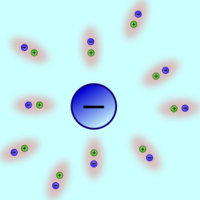Uehling potential

Ok kiddo, imagine you have two magnets. If you try to push them together so the same poles touch each other, they will resist and it will be really hard to push them together. That's because like charges repel each other.
Now, imagine you have two protons in the nucleus of an atom. They both have a positive charge, so they should repel each other, right? But they're stuck together in the nucleus. How does that work?
The answer is called the nuclear force. It's what "glues" protons and neutrons together in the nucleus. But even though it's really strong, it doesn't completely overcome the repulsion between protons.
That's where the Uehling potential comes in. It's a correction to the nuclear force that takes into account the fact that protons repel each other. It's named after a scientist named George Uehling who discovered it.
The Uehling potential basically says that if you have two protons close together, there will be a "cloud" of virtual particles (like electrons and their antiparticles, positrons) that pop in and out of existence around them. This cloud will shield the protons from each other's repulsion a little bit. It's kind of like putting a screen door between two magnets - they still repel each other, but it's not as strong.
So, the Uehling potential helps explain why protons can still stick together in the nucleus even though they repel each other. It's like a little boost that helps the nuclear force do its job.
Now, imagine you have two protons in the nucleus of an atom. They both have a positive charge, so they should repel each other, right? But they're stuck together in the nucleus. How does that work?
The answer is called the nuclear force. It's what "glues" protons and neutrons together in the nucleus. But even though it's really strong, it doesn't completely overcome the repulsion between protons.
That's where the Uehling potential comes in. It's a correction to the nuclear force that takes into account the fact that protons repel each other. It's named after a scientist named George Uehling who discovered it.
The Uehling potential basically says that if you have two protons close together, there will be a "cloud" of virtual particles (like electrons and their antiparticles, positrons) that pop in and out of existence around them. This cloud will shield the protons from each other's repulsion a little bit. It's kind of like putting a screen door between two magnets - they still repel each other, but it's not as strong.
So, the Uehling potential helps explain why protons can still stick together in the nucleus even though they repel each other. It's like a little boost that helps the nuclear force do its job.
Related topics others have asked about:
